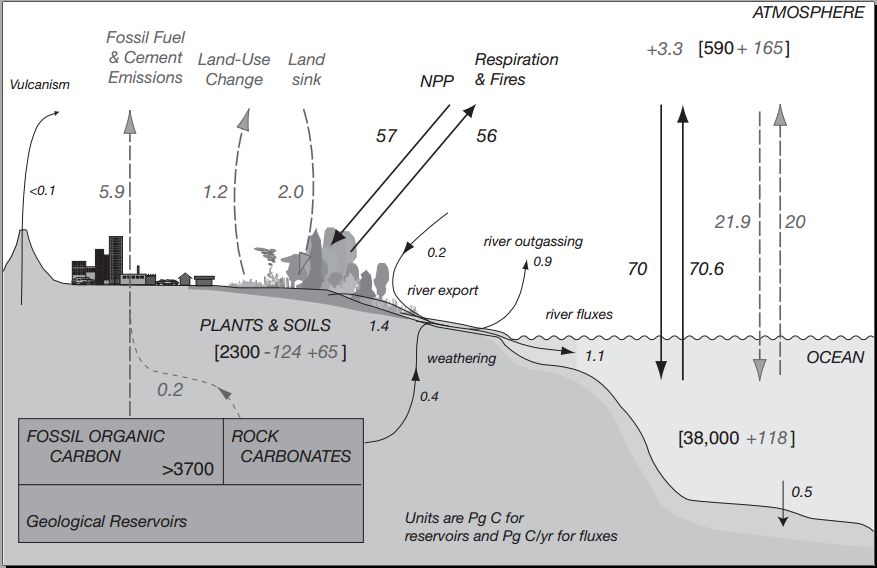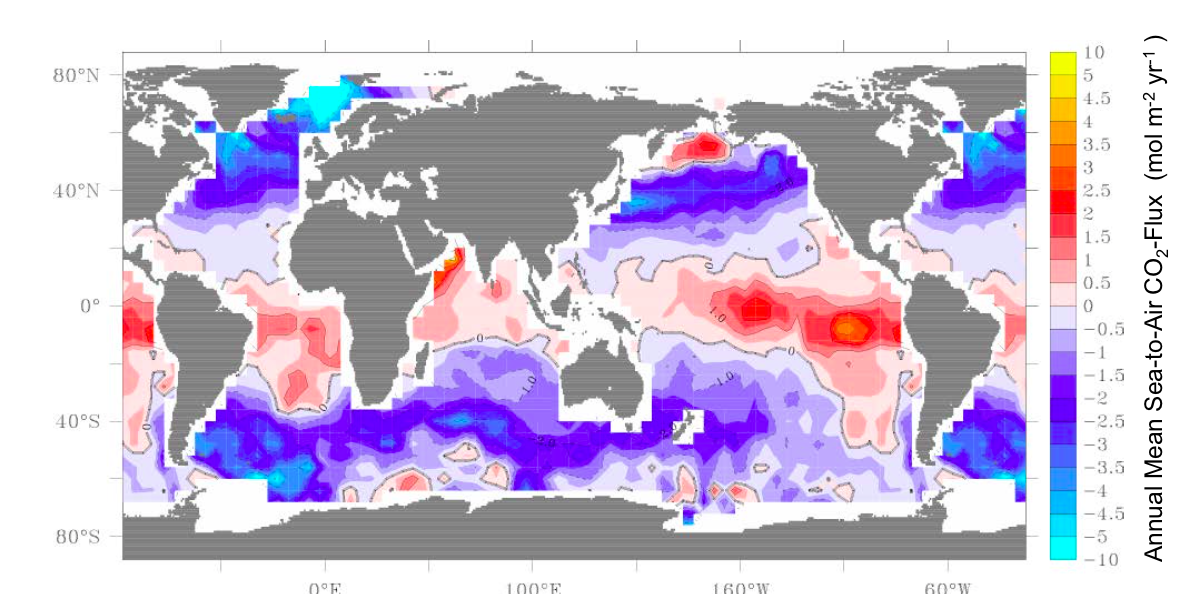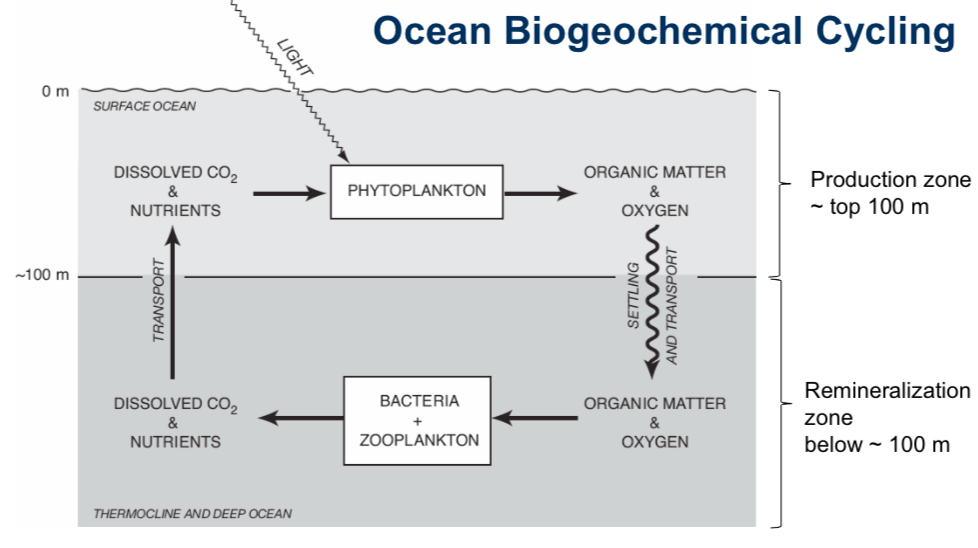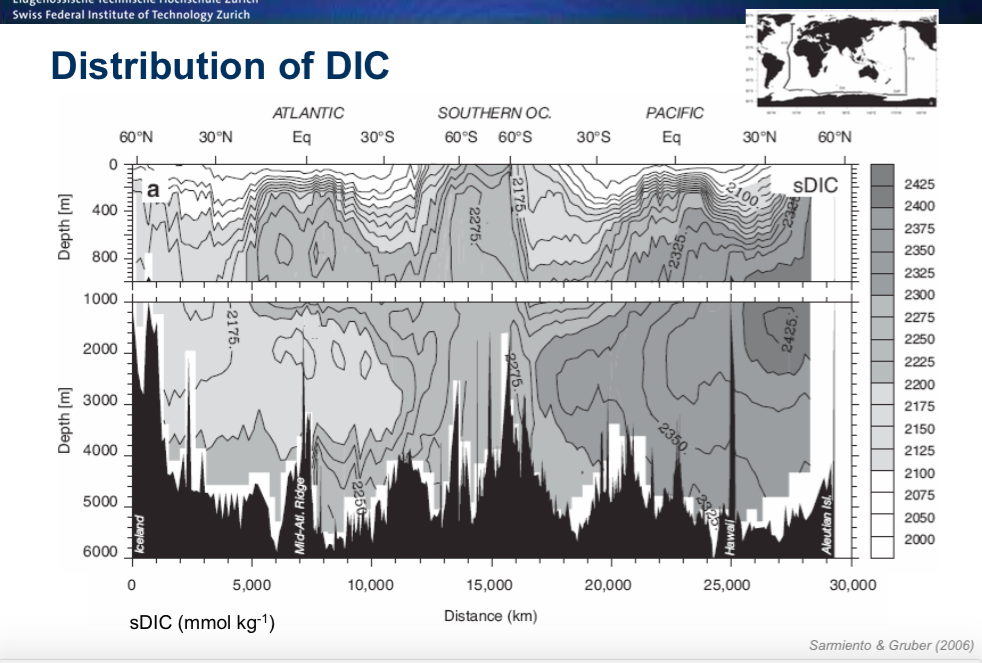Table of Contents
The Ocean's Carbon Cycle
Author: Simon Baumgartner
The role of the Ocean in the carbon cycle
Carbon has 4 major reservoirs: atmosphere, biosphere, hydrosphere, geosphere. The global Carbon Cycle describes the distribution to this reservoirs and the fluxes between them.
CO$_2$ in the atmosphere is one of the most important anthropogenic greenhouse gases, due to the burning of fossil fuels. But the amount of CO$_2$ in the atmosphere compared to the Carbon in the ocean is really small.
The most input of Carbon in the oceans comes from the surface exchange with the atmosphere. The uptaken CO$_2$ converts into carbonate. A small amount enters through rivers as DOC. Although the DIC concentration in the surface layer is really high, the concentration in the deep layer is about 15% higher. The DIC in the deeper layer can be storaged over a much longer time period.
The oceans are the most important sink of atmospheric anthropogenic caused CO$_2$, although the uptake is limited by various factors.

Forms of carbon in the ocean
Inorganic Carbon
Dissolved atmospheric CO$_2$ hydrates to carbonic acid (H$_2$CO$_3$). This carbonic acid can deprotonate two times to bicarbonate (HCO$_3$) and carbonate (CO$_3$). In the seawater exist all these species and are an important chemical buffer for regulating the pH and the pCO$_2$ in the ocean. 88% of the inorganic Carbon in the seas is in form of bicarbonate, 11% as carbonate, and only about 1% as CO$_2$.
Organic Carbon
Organic carbon in the ocean can be dissolved or particulate.
Carbon pumps
Physical pump
Carbon gets stored in a long term in the deep waters of the oceans. The physical carbon pump functions the best in cold waters, because it can uptake the most amount of CO$_2$ and the cold water sinks faster because of its higher density.
Biological pump
The biological pump is a part of the carbon cycle. It's the part, where carbon from the atmosphere gets transported in the deep sea through organic matter. You can distinguish 3 diffrent phases: First, CO$_2$ gets fixed by phytoplankton due to photosynthesis. If these organisms die, they either stay in the euphotic zone and are nutrients for other organisms, or they die and sink to the ocean floor (they sink faster through aggregation). But only a small amount reaches the ocean floor, the rest gets eaten on the way there. Particels which reached the ocean floor stay in the sediment for a long time. This is an important sink of atmospheric CO$_2$. Without this mechanism, concentrations of CO2in the atmosphere would be substantially higher. There are estimates that without the biological pump, CO2-concentration in the atmosphere would more than double.
Biological pump efficiency
The overall efficiency of the biological pump depends on a combination of physical and biogeochemical factors. Both light and nutrients must be available in sufficient quantities for plankton. Enough particles must sink to recycle nutrients into deep waters, and upwelling must occur to bring nutrients back to the surface. Factors that can impede this process include ocean warming (which makes the sea's layers more stratified, preventing mixing that brings up nutrients), and pollution and turbulence, which can reduce the penetration of sunlight at the surface.
OCEANS. Sink or source of carbon?
If the ocean is a sink or a source of carbon depends strongly from the region. Colder & turbulent regions can dissolve more atmospheric CO$_2$ than warmer oceans. Studies nowadays say, that oceans are a net sink. But if CO$_2$-emissions further increases and the global warming continues, the ocean surface temperature can increase also. A higher surface temperature means less CO$_2$ can dissolve. It might be, that the oceans become a global net CO$_2$ source.
How is dissolved inorganic carbon distributed in the oceans?
What factors limit marine biological productivity?
The most important factor is the abundance of macro nutrients like N, P, or Si. To be able to grow photosynthesis is necessary as well. Therefore light condition is also a relevant factor, which is seasonal dependent. If there is enough nutrients abundant the growing rate of plants can be sensitive to the temperature. The temperature condition has then a relevant impact on the productivity, especially in cold regions and it is also seasonal dependent. HNLC represents a region, where the macro nutrients are not the limiting factor. HNLC stands for High Nutrient – Low Chlorophyll. These regions are in the North & Equatorial Pacific and in the Southern Ocean. HNLC regions exhibit the lowest biological pump efficiencies, because biology can not use up all the available nutrients, so other factors limit biological productivity, i.e light. Moreover, the availability of micro nutrients (in particular Fe) can be essential for the extent of the biomass. This can be the case in HNLC-regions.
Distribution of net primary production in the oceans
Sources
- IPCC Fourth Assessment Report: Climate Change 2007; Chapter 7.3.4
- Jorge L. Sarmiento and Nicolas Gruber: Ocean Biogeochemical Dynamics, Chapter 10
Comments
Please amend the article: — Samuel Eberenz 2015/05/05 12:40
- add definition and brief explanation of the biological pump efficiency
- add the factors controlling sea-air exchange of carbon (CO_$2$) and a gobal map of this exchange.



